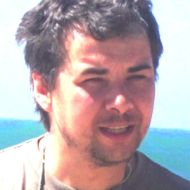Current Progress
Invasive neurointerfaces
Our main task at the Center for bioelectric interfaces lies in developing the fundamental and technological foundations for creating electrocorticographic invasive interfaces. To this end we have established a collaboration with a leading neurosurgery clinic, have developed a range of experimental paradigms, built and tested novel computational architectures for decoding invasively recorded brain activity into the movements of the hand prosthesis.
As a byproduct of this activity we have developed a novel, safe and accurate procedure that can be used in the operating room for passive mapping of the eloquent speech cortex during the neurosurgical interventions. Using this procedure it is possible to localize cortical areas serving speech production function to spare them from resection during neural tissue removal surgeries.
Sinkin M.V., Osadchiy A.E., Lebedev M.А. et al. High resolution passive speech mapping in dominant hemisphere glioma neurosurgery. Neyrokhirurgiya = Russian Journal of Neurosurgery 2019;21(3):00–00.
Non-invasive neurointerfaces
We have developed motor-imagery interface that can be used to control the lower limbs exoskeleton in patients during the rehabilitation process.
It has been hypothesized that such therapy including actuation of the exoskeleton on the basis of the specific brain activity significantly improves recovery in post-stroke patients. In collaboration with Exoatlet company we are now setting up an Exogym for post-stroke patients to be able to receive the necessary exoskeleton based therapy including its brain-controlled version.
To increase the efficiency of the non-invasive brain-computer interfaces, a method for analyzing EEG data was developed, which allows for a more accurate classification of states when creating a motor-imagery interface; the results are published by N. Dagaev, K. Volkova, A. Ossadtchi. (2017). Latent variable method for automatic adaptation to background states in motor imagery BCI. Journal of Neural Engineering, 15 (1).
Neurofeedback
We are interested in exploring the changes in ongoing brain activity induced by the neurofeedback intervention. We have recently published an article A. Ossadtchi, T. Shamaeva, E. Okorokova, V. Moiseeva, M. A. Lebedev. (2017). Neurofeedback learning modifies the incidence rate of alpha spindles, but not their duration and amplitude. Scientific Reports, 7, 3772. that discusses the changes in the patterns of alpha activity recorded in the P4 EEG lead as a result of a two-day training in the neurofeedback paradigm. It shows that in specific setting NFB training is about learning to make rare events in the brain activity more frequent.
To facilitate our studies we have developed a software for implementation of experimental paradigms in neurofeedback and other real-time EEG applications N. Smetanin, K. Volkova, S. Zabodaev, M. A. Lebedev, A. Ossadtchi. (2018). NFBLab - A Versatile Software for Neurofeedback and Brain-Computer Interface Research. Frontiers in Neuroinformatics.
We believe that the efficiency of training in the NFB paradigm depends on the feedback signal specificity. Delivering feedback on time is of crucial importance and thus we are developing methods to reduce the delay in estimation of the fundamental parameters of brain oscillations N. Smetanin, M. A. Lebedev, A. Ossadtchi published. (2018). Towards Zero-Latency Neurofeedback.
We have developed a new approach to the localization of the verbal cortex, which does not require the construction of a reference distribution. According to our new technique there is no need to record the patient's brain activity at rest, which significantly simplifies the implementation of the procedure of passive mapping of the non-redundant verbal cortex. Artur Petrosyan, Mikhail Sinkin, Mikhail Lebedev and Alexei Ossadtchi (2021). Decoding and Interpreting Cortical Signals With A Compact Convolutional Neural Network, Journal of Neural Engineering, https://doi.org/10.1088/1741- 2552/abe20e
We investigated the application of a small set of spatially separated invasive EEG electrodes for speech decoding. Artur Petrosyan, Alexey Voskoboinikov, Dmitrii Sukhinin, Anna Makarova, Anastasia Skalnaya, Nastasia Arkhipova, Mikhail Sinkin and Alexei Ossadtchi (2022). Speech decoding from a small set of spatially segregated minimally invasive intracranial EEG electrodes with a compact and interpretable neural network. Journal of Neural Engineering, v.19, n.6 066016 https://doi.org/10.1088/1741-2552/aca1e1.
The inverse problem of EEG and MEG
We are active in the methodological aspects of EEG and MEG and develop both software and algorithmic solutions to improve the accuracy and speed of functional brain imaging. To this end we have developed the software for non-invasive imaging of the functioning brain in real-time. The video with the demonstration can be found on our youtube channel.
Communication between brain assemblies is a fundamental and defining property of the brain. So far we are able to visualize non-invasively only a small fraction of the inter-areal communication taking place in the brain. We have developed a novel method for searching for connectivity in MEG data sensitive to the broader range of functional communication scenarios.The algorithm is published in the article by A. Ossadtchi, D. Altukhov, K. Jerbi. (2018). Phase shift invariant imaging of coherent sources (PSIICOS) from MEG data. Neuroimage, 183: 950-971.
Improving spatial resolution of MEG is crucial for expanding the applicability of this unique non-invasive functional brain imaging method. Our novel approach allows for spatial super-resolution when imaging activity of functionally connected brain areas. This paper is currently under review in the Neuroimage journal. Its preprint is available at A. Kuznetsova, Y. Nurislamova, A. Ossadtchi. Modified covariance beamformer for solving MEG inverse problem in the environment with correlated sources. (2019).
We developed the biomimetic approach for automatic spike detection. Daria Kleeva, Gurgen Soghoyan, Ilia Komoltsev, Mikhail Sinkin and Alexei Ossadtchi. Fast parametric curve matching (FPCM) for automatic spike detection (2022). Journal of Neural Engineering, v.19, n.3 036003. https://doi.org/10.1088/1741-2552/ac682a.
Atomic magnetometric sensors
Novel generation of MEG devices based on the optically pumped magnetometers is significanly more compact and sensitive than those built using the traditional SQUID-based technology. In collaboration with Together with physicists from Ioffe institute for physics and technology RAS we are developing a new atomic magnetometric sensor for multichannel magnetoencephalography.
A. S. Pazgalev, A. E. Ossadtchi, S. P. P. Dmitriev, V. A. Kartoshkin, M. V. Petrenko, A. K. Vershovskii. High sensitivity laser pumped Cesium magnetic sensor for magnetoencephalography. - Proc. MPLP’2018 - VIII International Symposium "Modern Problems of Laser PHYSICS", Novosibirsk, Russia, August 25 - September 1, 2018, pp. 189-190.
We presented the first solid-state sensor for MEG that works at room temperature. Koshev, N., Butorina, A., Skidchenko, E., Kuzmichev, A., Alexei Ossadtchi, Ostras, M., & Vetoshko, P. (2021). Evolution of MEG: A first MEG-feasible fluxgate magnetometer. Human Brain Mapping, 42(15), 4844-4856. https://doi.org/10.1002/hbm.25582
Patent: by A. K. Vershovskii, A. E. Ossadtchi. The method of controlling an atomic quantum magnetometer sensor when operating as part of a multichannel MEG system.
Have you spotted a typo?
Highlight it, click Ctrl+Enter and send us a message. Thank you for your help!
To be used only for spelling or punctuation mistakes.

